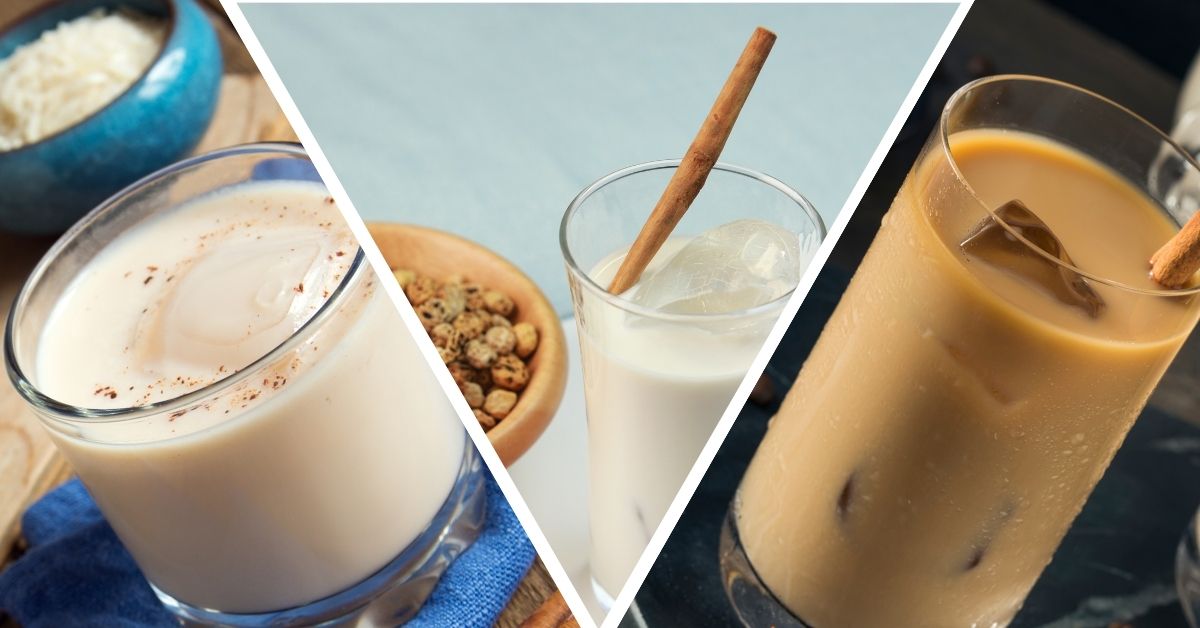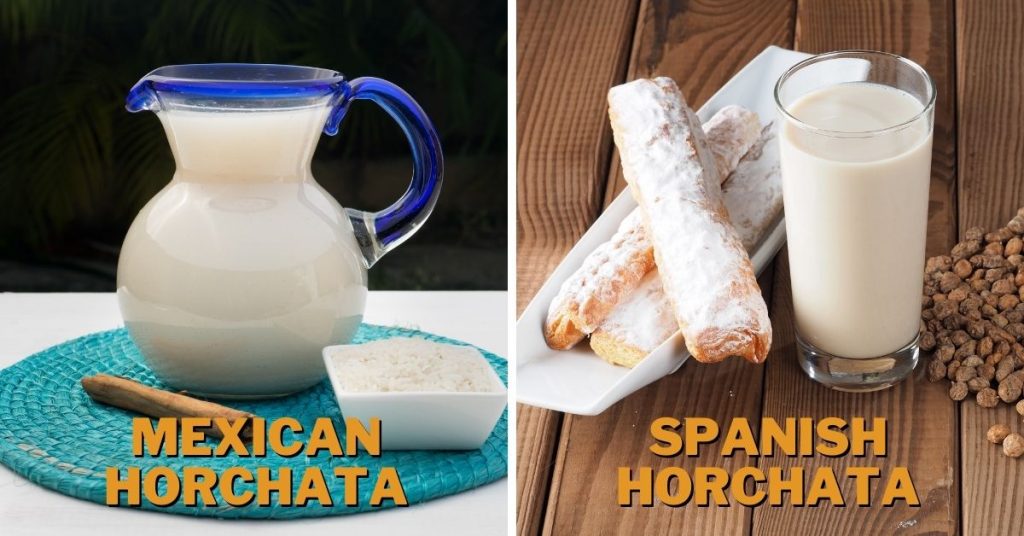Mexican vs. Spanish vs. Salvadorian Horchata: Differences

Horchata is the common name for several plant-based drinks. Different regions of the world have their own methods of preparation, which has led to many variations of horchata. Three of the more popular variations are Mexican, Spanish, and Salvadorian. But how are these drinks different from one another?
The key component in Mexican horchata is rice, in Spanish horchata are tiger nuts, and in Salvadorian are morro seeds. Moreover, while Mexican and Spanish horchata soaks the dry ingredients first, Salvadorian horchata sun-dries or toasts the seeds before adding the liquid.
The flavor of Horchata can vary dramatically depending on which region it is from. So, in this article, we are going to explore three different Horchatas and look at their preparation, ingredients, tastes, nutrition, etc. Plus, we will also discuss some other varieties of Horchatas in the world.
Mexican Horchata vs. Spanish Horchata: Differences
Let’s look into the differences between Mexican and Spanish horchata first to avoid any confusion.
Preparation
Mexican Horchata
In Mexico, the full name of this drink is “horchata de Arroz”. Arroz is the Spanish word for rice, which is the primary ingredient in the Mexican preparation of horchata.
Traditional Mexican horchata is a combination of rice, water, and cinnamon, and often includes sugar, and vanilla. First, the rice and cinnamon are soaked in water overnight or at least a few hours to soften up. Then the rice water, aka rice milk, is grounded into a smooth mixture and strained with a sieve or cheesecloth.
Alternatively, you can strain the water after soaking the dry ingredients and use milk as the source of liquid. After straining the liquid into a pitcher, you can add sugar, vanilla extract, and even condensed milk or lemon juice for some acidity.
Spanish Horchata
While its Mexican counterpart may be more well-known in certain parts of the world, Spanish horchata actually came first. After the drink was brought over from its origin place of North Africa to Spain, the knowledge of the drink spread to other parts of the New World, eventually finding variations in Mexico, Salvador, and Puerto Rico.
Horchata de Chufa is the Spanish name for this drink. Chufa means “tiger nuts” in Spanish, which once again highlights the primary ingredient for this drink.
Despite using different ingredients, Spanish horchata also soaks the tiger nuts for several hours (preferably overnight) before blending it with other ingredients. The rest of the preparation is pretty similar to both horchatas.
You strain the blended mixture through a fine-mesh sieve or cheesecloth until all the liquid comes out. Then you add in sugar to taste and vanilla extract and ground cinnamon as garnish.
Taste
Pretty much all variations of horchata have a few things in common. They are all refreshing drinks with a mildly sweet taste and creamy, smooth texture.
But Spanish horchata has a noticeably nutty taste with the addition of tiger nuts compared to Mexican horchata. On the other hand, Mexican horchata has a creamier feel than its Spanish counterpart.
Mexican horchata tastes almost like a liquid rice pudding.
Ingredients
The key point of distinction between Mexican and Spanish horchata is in the primary ingredient. Mexican horchata is a rice-based drink whereas Spanish horchata utilizes tiger nuts. The rest of the ingredients are pretty much identical with cinnamon, sugar, milk, vanilla extract, lemon juice or lemon zest, being common add-ins.
Another popular add-in in Mexican horchata is strawberries which make this beverage even sweeter.
Uses
Both drinks are made and served as refreshing drinks, typically in the summer. But whereas Spanish Horchata is almost always served chilled or with ice, Mexican horchata is prepared either cold or hot. Some even prefer to drink it with coffee for a coffee-flavored horchata. Starbucks, the famous coffee brand, has even put out a horchata-flavored frappuccino.
Nutrition
The nutritional value of horchata is going to vary drastically depending on the specific preparation. Even in the same region, horchata can be prepared with slight variations of the original formula.
But typically, Mexican horchata has a lot more sugar and carbohydrate compared to Spanish horchata. This is because Spanish horchata contains tiger nuts, which are already naturally sweet. So, you do not have to add as much sugar to make it sweet. This also means that Mexican horchata has more calories per serving.
Also, tiger nuts contain more protein per serving than rice milk. But Mexican horchata has pretty much no amount of fat unless you use milk in it. Spanish horchata, even without adding milk to it, has a significant amount of fat. A single serving of Spanish horchata can have 6-10 grams of fat. [1]
Pairing
Mexican horchata is often paired with fresh bread or pastries. In Mexico, you will often see various fruits such as cantaloupe, berries, or apricots accompany the drink. The drink also goes well with savory dishes such as tacos, pork carnitas, and tostadas.
On the other hand, Spanish horchata is most often paired with fartons, which is a donut-like pastry you will find all over Spain. You dip the pastries into the drink and eat it.

Mexican Horchata vs. Salvadorian Horchata: Differences
Preparation
Salvadorian Horchata
Salvador has their own version of horchata, which the locals refer to as “horchata de morro”. Like its brethren, the name is derived from its primary ingredient. In this case, the seeds of the morro tree, which is a species of plant native to Central America and Southern Mexico.
Unlike its other counterparts, here you sun-dry the seeds and then ground them into powder. In modern times, you roast the different dry ingredients and then turn them into powder with the help of a food processor or blender. Then the requisite amount of liquid is added to the mix along with things like ground cinnamon, vanilla, sugar, sea salt, milk, etc.
Finally, the resulting mixture is filtered through a sieve or cheesecloth to get a smooth and homogenous mixture. People also blend the drink with ice to make a chilled glass of horchata.
Mexican Horchata
Traditionally, people prepare Mexican horchata by soaking rice in water with or without some spices. Then they remove the water and ground the dry ingredients such as rice, nuts, and cinnamon. They then mix water or milk into the dry ingredients and strain the liquid through a fine sieve.
Finally, you can mix additional ingredients such as sugar, ground cinnamon, vanilla extract, lemon juice, etc. to the liquid and stir. The drink is commonly served chilled but you can also enjoy it hot.
Ingredients
Typically, Salvadoran horchata is a mixture of grounded morro seed, white rice, cinnamon, nutmeg, etc. which you then brew with water or milk. Then you filter the liquid through a sieve and add things such as ground allspice, ground cinnamon, and, of course, sugar. Alternatively, some make this drink from gourd seeds like pumpkin or squash.
On the other hand, Mexican horchata uses white rice almost exclusively. Additional elements include ground cinnamon, vanilla extract, sugar, cloves, lemon juice, etc.
Taste
Salvadorian horchata can have a nuttier taste than Mexican horchata. Both have a very creamy and smooth texture. Also, Salvadorian horchata tends to include more spices than typical Mexican variations.
Add-Ins
Common add-ins for Salvadorian horchata include ground cinnamon, cloves, ground all-spice, vanilla extract, cocoa beans, ground sesame seeds, and nuts.
Common add-ins in a Mexican horchata are ground cinnamon, some vanilla, and a touch of lemon juice or lemon zest for acidity.
To sum up the differences here is your cheat sheet:
| Feature | Mexican Horchata | Spanish Horchata | Salvadorian Horchata |
|---|---|---|---|
| Key Ingredient | Rice | Tiger nuts | Morro seeds |
| Preparation | Rice is soaked in water first and then grounded | Tiger nuts are soaked in water first and then grounded | The seeds are sun-dried or ground first and then soaked |
| Common Add-ins | Ground cinnamon, vanilla, lemon juice | Ground cinnamon, lemon juice | Ground cinnamon, cloves, sesame seeds, etc. |
| Local Designation | Horchata de Arroz | Horchata de Chufa | Horchata de Morro |
What Is Horchata de Morro?
Horchata de morro is the native name for the Salvadorian variation of horchata. Here, the word morro refers to the seeds of the morro tree, which is one of the key ingredients in this drink.
What Is Horchata de Melon?
Horchata de melon is a variation of horchata that is made with melon seeds. People also use seeds of other gourds for this recipe.
What Is Horchata de Ajonjolí?
The most common version of horchata in Puerto Rico is horchata de ajonjolí. This version is made from toasted sesame seeds that are ground into powder and then mixed with a liquid and various spices. People of that region consume this drink on its own or with cereals and smoothies.
How Do You Make Ecuadorian Horchata?
Without a doubt, the most distinct variation of horchata hails from the nation of Ecuador. This drink is an infusion of 18 different herbs and flowers. The drink has an easily distinguishable, clear red complexion. Some of the ingredients include bloodleaf, lemon verbena, lemongrass, mint, chamomile, etc.
To conclude, regardless of which source ingredient you use, horchatas are light, refreshing, and creamy drinks that you can enjoy on their own or with other dishes. No wonder it has flourished in so many parts of the world in different forms.
